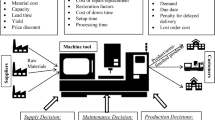Abstract
In most manufacturing industries, tool replacement policy is essential for minimizing the fraction defective and the manufacturing cost. Tool wear is caused by the action of sliding chips in the shear zone, and the friction generated between the tool flank and workpiece. This wear, apparently, is a dominant and irremovable component of variability in many machining processes, which is a systematic assignable cause. As the tool wear occurs in the machining processes, the fraction of defectives would gradually become significant. When the fraction defective reaches a certain level, the tool must be replaced. Therefore, detecting suitable time for tool replacement operation becomes essential. In this paper, we present an analytical approach for unilateral processes based on the one-sided process capability index C PU (or C PL ) to find the appropriate time for tool replacement. Accurate process capability must be calculated, particularly, when the data contains assignable cause variation. By calculating the index C PU (or C PL ) in a dynamical environment, we propose estimators of C PU (or C PL ) and obtain exact form of the sampling distribution in the presence of systematic assignable cause. The proposed procedure is then applied to a real manufacturing process involving tool wear problem, to demonstrate the applicability of the proposed approach.






Similar content being viewed by others
References
Alwan LC and Roberts HV (1988). Time series modeling for statistical process control. J Bus Econ Stat 6(1): 87–95.
Bothe DR (1997). Measuring Process Capability. McGraw-Hill: New York.
Burr IW (1979). Elementary Statistical Quality Control. Marcell Dekker: New York, NY.
Chan LK, Cheng SW and Spiring FA (1988). A new measure of process capability C pm . J Quality Technol 20(3): 162–175.
Harry MJ (1988). The Nature of Six Sigma Quality. Motorola Inc.: Schaumburg, Illinois.
Kane VE (1986). Process capability indices. J Quality Technol 18(1): 41–52.
Kotz S and Johnson NL (1993). Process Capability Indices. Chapman & Hall: London.
Kotz S and Johnson NL (2002). Process capability indices—a review, 1992–2000. J Quality Technol 34(1): 1–19.
Kotz S and Lovelace C (1998). Process Capability Indices in Theory and Practice. Arnold: London, UK.
Kushler R and Hurley P (1992). Confidence bounds for capability indices. J Quality Technol 24: 188–195.
Long JM, De Coste MJ (1988). Capability studies involving tool wear. ASQC Quality Congress Transactions, Dallas, pp 590–596.
Montgomery DC (1985). Introduction to Statistical Quality Control, 3rd ed.. John Wiley & Sons: New York.
Palmer K and Tsui KL (1999). A review and interpretations of process capability indices. Ann Opns Res 87: 31–47.
Pearn WL, Kotz S and Johnson NL (1992). Distributional and inferential properties of process capability indices. J Quality Technol 24(4): 216–231.
Pearn WL and Shu MH (2003). Lower confidence bounds with sample size information for C pm with application to production yield assurance. Int J Product Res 41(15): 3581–3599.
Porter LJ and Oakland JB (1991). Process capability indices—an overview of theory and practices. Quality Reliab Eng Int 7: 437–448.
Quesenberry CP (1988). An SPC approach to compensating a tool wear process. J Quality Technol 20(4): 220–229.
Rodriguez R (1992). Recent developments in process capability analysis. J Quality Technol 24(4): 176–187.
Spiring FA (1991). Assessing process capability in the presence of systematic assignable cause. J Quality Technol 23(2): 125–134.
Spiring FA (1997). A unifying approach to process capability indices. J Quality Technol 29(1): 49–58.
Spiring F, Leung B, Cheng S and Yeung A (2003). A bibliography of process capability papers. Quality Reliab Eng Int 19(5): 445–460.
Vännman K and Hubele NF (2003). Distributional properties of estimated capability indices based on subsamples. Quality Reliab Eng Int 19(2): 111–128.
Vännman K and Kotz S (1995). A superstructure of capability indices distributional properties and implications. Scand J Stat 22: 477–491.
Vasilopoulos AV and Stamboulis AP (1978). Modification of control chart limits in the presence of data correlation. J Quality Technol 10(1): 20–30.
Wallgren E (1996). Properties of the Taguchi capability index for Markov dependent quality characteristics. Technical report, Department of Mathematics, University of Örebro, Sweden.
Yang K and Hancock WM (1990). Statistical quality control for correlated samples. Int J Product Res 28(3): 595–608.
Author information
Authors and Affiliations
Corresponding author
Rights and permissions
About this article
Cite this article
Pearn, W., Hsu, YC. & Horng Shiau, JJ. Tool replacement policy for one-sided processes with low fraction defective. J Oper Res Soc 58, 1075–1083 (2007). https://doi.org/10.1057/palgrave.jors.2602224
Received:
Accepted:
Published:
Issue Date:
DOI: https://doi.org/10.1057/palgrave.jors.2602224



